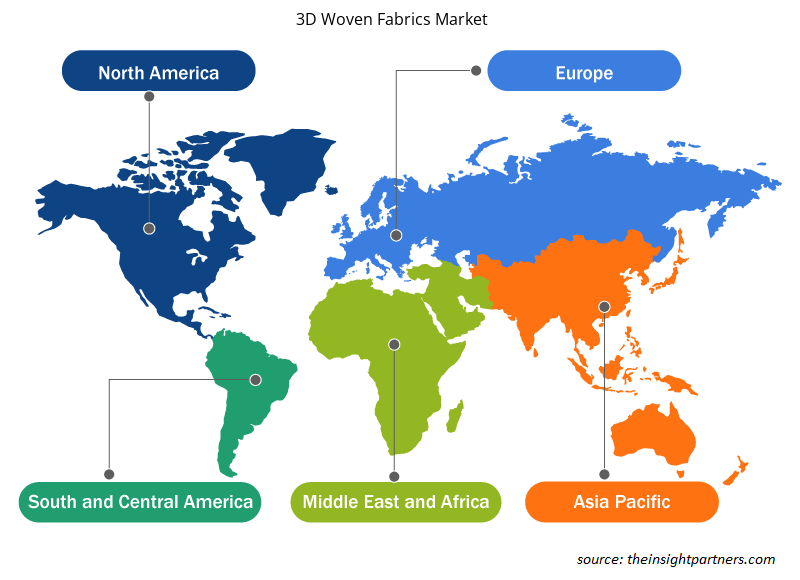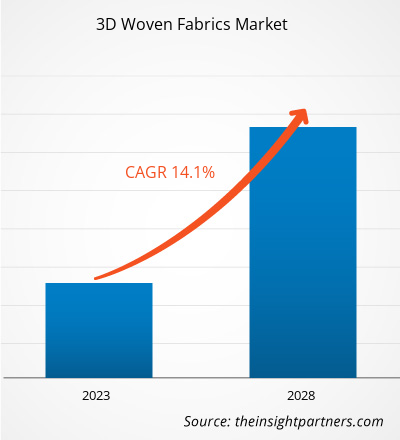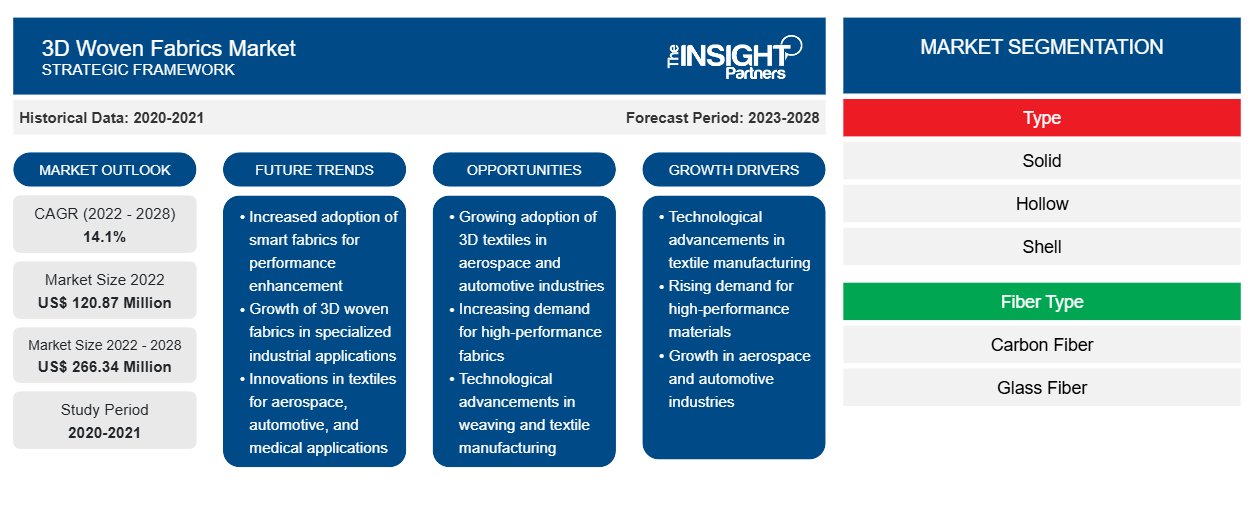[Rapport de recherche] La taille du marché des tissus tissés 3D devrait passer de 120,87 millions USD en 2022 à 266,34 millions USD d'ici 2028 ; elle devrait croître à un TCAC de 14,1 % de 2022 à 2028.
Les tissus tissés en 3D sont plus légers que la plupart des bois et des métaux. La légèreté des tissus tissés en 3D rend leur utilisation importante dans les avions et les automobiles, où un poids plus léger offre une meilleure efficacité énergétique. De nos jours, les concepteurs d'avions sont très préoccupés par le poids, car la réduction du poids d'un appareil réduit la quantité de carburant dont il a besoin et augmente la vitesse qu'il peut atteindre. De plus, les tissus tissés en 3D résistent aux dommages causés par les intempéries et les produits chimiques agressifs. Ils peuvent être moulés dans des formes complexes plus facilement que la plupart des autres matériaux.
En 2022, l'Europe détenait la plus grande part de revenus du marché mondial des tissus tissés 3D. La demande de tissus tissés 3D en Europe augmente en raison de l'augmentation des activités de R&D concernant l'utilisation de tissus tissés 3D dans les industries d'utilisation finale telles que l'aéronautique, l'automobile, le bâtiment et la construction, et bien d'autres. Les tissus tissés 3D en Europe ont le potentiel de créer des opportunités pour les affaires, l'exportation et les applications de fabrication avancées pour les industries aérospatiale et automobile de la région. Cela a entraîné une augmentation rapide de la popularité des tissus tissés 3D en Europe. Selon la Commission européenne, l'Union européenne a investi environ 103 milliards de dollars américains dans le programme de financement de la recherche et de l'innovation - Horizon 2021 - de 2021 à 2027. Il s'agissait de financer le développement de textiles avancés utilisés dans les secteurs des transports et de l'aéronautique. Tous ces facteurs contribuent positivement à la croissance du marché des tissus tissés 3D dans la région.
Personnalisez ce rapport en fonction de vos besoins
Vous bénéficierez d'une personnalisation gratuite de n'importe quel rapport, y compris de certaines parties de ce rapport, d'une analyse au niveau des pays, d'un pack de données Excel, ainsi que de superbes offres et réductions pour les start-ups et les universités.
-
Obtenez les principales tendances clés du marché de ce rapport.Cet échantillon GRATUIT comprendra une analyse de données, allant des tendances du marché aux estimations et prévisions.
Impact de la pandémie de COVID-19 sur le marché des tissus tissés 3D
Les industries telles que l'automobile, l'aérospatiale, le bâtiment et la construction, la défense et l'armée ont été les principaux contributeurs à la demande de tissus tissés 3D. En 2020, ces industries ont dû ralentir leurs opérations en raison des perturbations de la chaîne de valeur causées par la fermeture des frontières nationales et internationales. La pénurie de main-d'œuvre a entraîné la décélération des opérations de production et de distribution de tissus tissés 3D. Les perturbations de la chaîne d'approvisionnement mondiale et la fermeture des installations de production de résine ont entraîné une forte hausse des prix des tissus tissés 3D. Les confinements imposés par différents pays en 2020 ont entravé la capacité des industries à maintenir les niveaux de stocks. De plus, les mesures sanitaires et autres précautions liées au COVID-19 ont considérablement réduit la capacité de production, créant une pénurie de stocks de tissus tissés 3D. Cependant, en 2021, le marché mondial a commencé à se remettre des pertes subies en 2020, les gouvernements de différents pays ayant annoncé un assouplissement des restrictions sociales. De plus, l'augmentation des taux de vaccination a contribué à l'amélioration des conditions générales dans différents pays, ce qui a conduit à des environnements propices au progrès industriel et commercial. En outre, l’augmentation des capacités de production dans l’automobile et d’autres industries en Europe et en Amérique du Nord a entraîné une augmentation de la demande de tissus tissés 3D en 2021.
Informations sur le marché
Demande croissante de tissus tissés en 3D dans l'industrie automobile et aéronautique
Les matériaux avancés sont essentiels pour augmenter la consommation de carburant des automobiles modernes tout en garantissant la sécurité et les performances. Le remplacement des composants en fonte et en acier traditionnels par des matériaux légers tels que les tissus tissés 3D à haute résistance réduit le poids de la carrosserie et du châssis d'un véhicule, réduisant ainsi la consommation de carburant d'un véhicule. De plus, les tissus tissés 3D conviennent à la fabrication de composants intérieurs non structurels, de dossiers de siège, de garnitures de pavillon, de panneaux intérieurs et de tableaux de bord. L'utilisation de composites renforcés de fibres naturelles augmente dans les applications aéronautiques en raison de la législation et des réglementations obligeant les fabricants à utiliser des matériaux durables et recyclés pour fabriquer des véhicules légers et économes en carburant. En outre, les constructeurs aéronautiques s'efforcent d'agrandir les structures thermoplastiques primaires des jets d'affaires et des avions commerciaux. Ils ont été les premiers à adopter les thermoplastiques renforcés de fibres longues.
Informations sur les types
En fonction du type, le marché mondial des tissus tissés 3D est segmenté en solide, creux, coque et nodal. La part de marché mondiale des tissus tissés 3D pour le segment solide était la plus importante en 2022. Le solide 3D fait référence aux architectures tissées avec des sections transversales solides soit dans un large panneau, soit dans une préforme en forme de filet. Il s'agit d'une structure comprenant des sections à parois multiples intégrées dans le sens de la largeur et de l'épaisseur du tissu, définissant une forme en coupe transversale sans aucune ouverture de type tunnel dans le sens de la longueur du tissu. Le solide 3D se compose d'entrelacements multicouches, orthogonaux et angulaires. L'orthogonal est basé sur des fils droits. Les fils de chaîne et de trame sont utilisés pour gérer l'épaisseur du tissu. Cette structure a une fraction volumique plus élevée que les autres. L'entrelacement d'angle est basé sur des couches individuelles. Chaque couche est différente d'une autre. Les structures solides 3D vont de deux à quatre couches. Le segment solide devrait connaître une croissance significative et représenterait la croissance de la taille du marché des tissus tissés 3D.
Les principaux acteurs opérant sur le marché mondial des tissus tissés 3D sont Textum OPCO LLC, Tex Tech Industries Inc, Sigmatex (UK) Ltd, 3D Woven SaRL, Tantra Composite Technologies Pvt Ltd, U-Long High Tech Textile Co Ltd, TEAM Inc, Changzhou Bolong Three Dimensional Composites Co Ltd, Topweaving New Material Tech Co Ltd et China Beihai Fiberglass Co Ltd. Les acteurs opérant sur le marché mondial des tissus tissés 3D se concentrent sur la fourniture de produits de haute qualité pour répondre à la demande des clients. Ils se concentrent également sur des stratégies telles que les investissements dans les activités de recherche et développement et le lancement de nouveaux produits.
Aperçu régional du marché des tissus tissés 3D
Les tendances régionales et les facteurs influençant le marché des tissus tissés 3D tout au long de la période de prévision ont été expliqués en détail par les analystes d’Insight Partners. Cette section traite également des segments et de la géographie du marché des tissus tissés 3D en Amérique du Nord, en Europe, en Asie-Pacifique, au Moyen-Orient et en Afrique, ainsi qu’en Amérique du Sud et en Amérique centrale.

- Obtenez les données régionales spécifiques au marché des tissus tissés 3D
Portée du rapport sur le marché des tissus tissés 3D
| Attribut de rapport | Détails |
|---|---|
| Taille du marché en 2022 | 120,87 millions de dollars américains |
| Taille du marché d'ici 2028 | 266,34 millions de dollars américains |
| Taux de croissance annuel composé mondial (2022-2028) | 14,1% |
| Données historiques | 2020-2021 |
| Période de prévision | 2023-2028 |
| Segments couverts |
Par type
|
| Régions et pays couverts |
Amérique du Nord
|
| Leaders du marché et profils d'entreprises clés |
|
Densité des acteurs du marché des tissus tissés 3D : comprendre son impact sur la dynamique commerciale
Le marché des tissus tissés 3D connaît une croissance rapide, tirée par la demande croissante des utilisateurs finaux en raison de facteurs tels que l'évolution des préférences des consommateurs, les avancées technologiques et une plus grande sensibilisation aux avantages du produit. À mesure que la demande augmente, les entreprises élargissent leurs offres, innovent pour répondre aux besoins des consommateurs et capitalisent sur les tendances émergentes, ce qui alimente davantage la croissance du marché.
La densité des acteurs du marché fait référence à la répartition des entreprises ou des sociétés opérant sur un marché ou un secteur particulier. Elle indique le nombre de concurrents (acteurs du marché) présents sur un marché donné par rapport à sa taille ou à sa valeur marchande totale.
Les principales entreprises opérant sur le marché des tissus tissés 3D sont :
- Textum OPCO LLC
- Tex Tech Industries Inc
- Sigmatex (Royaume-Uni) Ltd
- Tissage 3D SaRL
- Tantra Composite Technologies Pvt Ltd
Avis de non-responsabilité : les sociétés répertoriées ci-dessus ne sont pas classées dans un ordre particulier.

- Obtenez un aperçu des principaux acteurs du marché des tissus tissés 3D
Rapports en vedette
- Tendances industrielles progressistes sur le marché des tissus tissés 3D pour aider les acteurs à développer des stratégies efficaces à long terme
- Stratégies de croissance des entreprises adoptées par les marchés développés et en développement
- Analyse quantitative du marché des tissus tissés 3D de 2020 à 2028
- Estimation de la demande mondiale de tissus tissés en 3D
- Analyse des cinq forces de Porter pour illustrer l'efficacité des acheteurs et des fournisseurs opérant dans l'industrie
- Développements récents pour comprendre le scénario concurrentiel du marché
- Tendances et perspectives du marché, ainsi que facteurs qui stimulent et freinent la croissance du marché des tissus tissés 3D
- Aide à la prise de décision en mettant en évidence les stratégies de marché qui sous-tendent l'intérêt commercial, conduisant à la croissance du marché
- La taille du marché des tissus tissés 3D à différents niveaux
- Aperçu détaillé et segmentation du marché, ainsi que la dynamique de l'industrie des tissus tissés 3D
- La taille du marché des tissus tissés 3D dans diverses régions avec des opportunités de croissance prometteuses
Marché mondial des tissus tissés 3D
En fonction du type, le marché des tissus tissés 3D est segmenté en solide, creux, coque et nodal. En fonction du type de fibre, le marché mondial des tissus tissés 3D est segmenté en fibre de carbone , fibre de verre et autres. En fonction de l'application, le marché des tissus tissés 3D est segmenté en balistique, aéronautique, transport, bâtiment et construction, et autres.
Profils d'entreprise
- Textum OPCO LLC
- Tex Tech Industries Inc
- Sigmatex (Royaume-Uni) Ltd
- Tissage 3D SaRL
- Tantra Composite Technologies Pvt Ltd
- U-Long High Tech Textile Co., Ltd.
- ÉQUIPE Inc
- Changzhou Bolong Composites tridimensionnels Co., Ltd.
- Topweaving New Material Tech Co., Ltd.
- Chine Beihai Fiberglass Co., Ltd.
- Analyse historique (2 ans), année de base, prévision (7 ans) avec TCAC
- Analyse PEST et SWOT
- Taille du marché Valeur / Volume - Mondial, Régional, Pays
- Industrie et paysage concurrentiel
- Ensemble de données Excel
Rapports récents
Rapports connexes
Témoignages
Raison d'acheter
- Prise de décision éclairée
- Compréhension de la dynamique du marché
- Analyse concurrentielle
- Connaissances clients
- Prévisions de marché
- Atténuation des risques
- Planification stratégique
- Justification des investissements
- Identification des marchés émergents
- Amélioration des stratégies marketing
- Amélioration de l'efficacité opérationnelle
- Alignement sur les tendances réglementaires























 Obtenez un échantillon gratuit pour - Marché des tissus tissés 3D
Obtenez un échantillon gratuit pour - Marché des tissus tissés 3D